#Salesforce File Management Solution
Explore tagged Tumblr posts
Text
#Salesforce external storage integration through connector#Salesforce File Management Solution#Salesforce integration challenges with external storage#Salesforce integration with external storage
0 notes
Text
Embracing AI for Document Management in Salesforce: MyDocify's Game-Changing Features
Salesforce is an integral platform for managing customer relationships and business processes. Document management plays a critical role within Salesforce by storing, organizing, and retrieving essential data, including contracts, proposals, and client information. Efficient document management ensures that teams can access accurate information swiftly, streamlining sales and customer service processes.
The evolution of AI in document management system software marks a significant shift from manual, time-consuming processes to intelligent, automated solutions. Traditionally, document handling involved manual data entry, storage, and retrieval, leading to inefficiencies and errors. However, AI-driven technologies have revolutionized this landscape by automating tasks, enhancing accuracy, and optimizing workflows. The integration of AI in document management systems has brought about increased efficiency, improved data accuracy, and better decision-making.
The Need for AI in Salesforce Document Management: Challenges Faced by Salesforce Users: Salesforce users grapple with multifaceted challenges in managing documents within their ecosystem. These obstacles often involve the daunting task of organizing extensive data repositories, engrossing manual data entry processes prone to errors, limited collaboration tools, and inefficient document tracking and management systems. The cumulative effect of these challenges results in hampered productivity, compromised data accuracy, and impediments in sustaining efficient customer relationship management (CRM).
Advantages of Integrating AI in Document Management The integration of Artificial Intelligence (AI) into Salesforce document management systems yields an array of compelling advantages. AI-powered solutions serve to automate repetitive tasks, such as mundane data entry and meticulous document tagging, thereby conserving substantial time and significantly reducing errors. Furthermore, the inclusion of AI augments search functionalities, facilitating swift and precise document retrieval within the Salesforce platform. This integration not only bolsters collaboration but also introduces predictive analytics capabilities and reinforces document security measures, fortifying the overall efficiency and reliability of document management within Salesforce.
Exploring MyDocify's AI-Enabled Features: Overview of MyDocify MyDocify is a cutting-edge document management system seamlessly integrated with Salesforce. It harnesses the power of AI to offer advanced features tailored for efficient document handling. With MyDocify, users can access a comprehensive suite of tools designed to streamline document management workflows, enhance productivity, and ensure data security.
Key Features: AI Analysis, Simplified Sharing, eSignature, and more At its core, MyDocify integrates AI Analysis, a powerful tool that extracts invaluable insights and information from documents, enabling users to access crucial data swiftly and effortlessly. This feature enhances decision-making processes by transforming unstructured data into actionable intelligence.
The platform's Simplified Sharing feature fosters seamless collaboration among teams, both internally and externally. It enables users to share and access documents effortlessly while maintaining strict control over document access, ensuring data confidentiality.
Moreover, the eSignature functionality within MyDocify ensures secure and hassle-free document signing processes, allowing users to obtain signatures promptly and track document statuses efficiently. Alongside these core features, MyDocify offers additional capabilities such as Auto Categorization, enabling automatic categorization of documents based on user-defined rules, and an advanced Search function that allows users to find specific documents swiftly through various search parameters.
MyDocify's Advanced Security measures, including robust encryption protocols, bolster the platform's credibility in maintaining data integrity and security. By amalgamating these diverse features and functionalities, MyDocify epitomizes a comprehensive document management solution tailored specifically for Salesforce users, optimizing their document-handling workflows while ensuring efficiency, security, and ease of use.
Benefits of AI in Document Management for Salesforce: Improved Efficiency and Productivity: By automating repetitive tasks, AI enhances efficiency, enabling Salesforce users to focus on high-value activities. MyDocify's AI Analysis and Search functionalities expedite document retrieval, saving time and boosting productivity. Additionally, streamlined workflows and simplified collaboration tools contribute to increased efficiency.
Enhanced Security and Compliance Measures: AI-driven document management solutions prioritize data security. MyDocify's Advanced Security features, such as encryption and access controls, ensure that sensitive information remains protected. Compliance with industry standards and regulations is also facilitated, mitigating risks associated with data breaches or non-compliance.
Streamlined Workflows and Collaboration: AI-enabled document management simplifies workflows by providing tools for easy sharing, collaboration, and version control. MyDocify's Simplified Sharing feature fosters seamless collaboration among teams, clients, and partners. This ensures real-time updates, reduces errors, and accelerates decision-making processes within Salesforce.
Implementation and Adoption Strategies: Best Practices for Leveraging AI-Enabled Document Management Implementing AI in Salesforce document management requires careful planning and execution. Strategies include comprehensive user training for seamless adoption, effective change management to align with organizational goals, and continuous evaluation of system performance. Ensuring user buy-in and defining clear objectives are crucial for successful implementation.
Future Prospects: The Future Trajectory of AI in Document Management for Salesforce The future of AI in Salesforce document management holds promising advancements. Predictive analytics, natural language processing (NLP), and continued integration with other Salesforce features are anticipated. These developments will further enhance efficiency, accuracy, and user experience within document management systems.
Final Thoughts: Embracing Artificial Intelligence (AI) in document management is a pivotal step for Salesforce users seeking streamlined operations, amplified productivity, and enhanced data accuracy. MyDocify stands as a powerful solution offering AI-driven functionalities that redefine document management within Salesforce.
With its robust integration of AI, MyDocify adeptly tackles challenges inherent in document management, significantly boosting operational efficiency, and improving overall user experiences. This comprehensive suite of AI-powered tools ensures secure, efficient, and collaborative document handling, making MyDocify an indispensable asset for contemporary businesses operating within the Salesforce ecosystem.
#salesforce#document management software#file sharing software#Salesforce Document Management#Cloud Storage Solutions#salesforce storage solution#Salesforce file storage software#file storage salesforce#Document Management Solution#Document Solutions for SF CRM#Document Management in Salesforce#Salesforce document management App#Salesforce CMS#Document management system#Salesforce documents management#document management system open source#cloud based storage#document control system#best document management software#document management system software#salesforce document management system#salesforce document storage
0 notes
Text
Small Business Must-Haves: The Best Tools for internal communication software
Team members can no longer rely on one-on-one conversations with coworkers in today's modernising workplace, and sending important files or sharing every little detail via email—which can take a lot of time because of its protocol—to accomplish these tasks. Selecting internal communication softwares can be the finest choice because it enhances time management, team productivity, and collaboration in addition to communication.
Little and microbusiness owners turn to social chat applications since they don't meet their needs and they believe work chat platforms are too expensive. Some were forced to use them due to an unforeseen pandemic disease. However, because of their subscription programs, some of the best products are able to provide excellent services at a low cost.
The following are some of the most effective communication tools for your business.
1. Troop Messenger

Troop Messenger is considered the best internal communication software, which can be used as a business messaging tool, work chat tool, and instant messaging tool for both office and remote work.
Troop Messenger shocked the market in a short amount of time, and many companies chose it after discovering its innovative capabilities, which are likely to be included in future updates of major applications or may not be present in apps available today.
Troop Messenger's thorough investigation led to the addition of new functions to the instrument, which is inexpensive and appropriate for use in any field. The military and NASA might exchange secret information using this safe and secure team texting tool.
Features
Remote screen sharing and controlling
Join Now, allows the user to join the missed group audio or video call while ongoing
Burnout
Live Location Tracking
Jointly Code
Advanced Search Filters
Forkout
2. Microsoft Teams

Office 365 plans can be accessed by users of Microsoft Teams, a proprietary internal communication software created by Microsoft and included in the Microsoft 365 product line. If you utilise more Microsoft apps at work, this is the right collaboration tool.
Features
Meeting Recordings
Screen sharing
All Microsoft 365 apps and services may be accessed with a single sign-on.
Cloud-based solution
100+ Participants capacity
3. Slack

Slack Technologies, an American software business that created the exclusive team communication platform Slack, was purchased by Salesforce in 2021. Because of its price, startups might be interested in it, and it could be a helpful tool for communication at work. It is a better alternative to email services because of its corporate key management, two-factor authentication, data encryption, and other features.
Features
Files sharing
Voice and Video calls
File sharing
Apps & Integrations
Slack Connect
4. Flock

Flock is a well-integrated enterprise communication tool with Twitter, Google Calendar, Trello, Jira, Google Drive, GitHub, and so on, which helps your team save time from switching between multiple tools.
Features
Well Integrated
Automate workflows
Polls
Notes
To-dos
Reminders
5. Twist

Twist was created to withstand the unique demands of contemporary work by a remote workforce consisting of more than 70 individuals across more than 25 nations. This internal communication software allows users to follow the thread conversations of users who are at least one month old. For distant workers, this team communication solution is perfect. To make user cooperation simple, Jira Software, Google Drive, Pipedream, Google Calendar, and other tools are integrated.
Features
Organized conversations
Private Conversations
Thread Conversations
Well Integrated
Project Management
6. Ryver

With emails, group chat, task management, and audio & video calls, Ryver allows the users to handle team communication in ONE APP. Ryver provides a discount to non-profit organizations and educational institutions, making it a useful team communication tool for them.
Features
Well Integrated
Task Management
Advanced Team Management
Custom Invite Links
Unlimited file sharing
Conclusion
We think the information on our blog will assist you in selecting the most appropriate technologies for internal communication software. Prior to selecting a chat tool, assess the demands of your business and carry out market research on the features, functionality, user or customer reviews, and other elements of the tool. As a result, you are not required to replace the tool even if it does not satisfy your needs.
#internal communication software#team communication#business communication tools#online communication apps#troop messenger#trending#tumblr#communication#viral
2 notes
·
View notes
Text
CLOUD COMPUTING: A CONCEPT OF NEW ERA FOR DATA SCIENCE
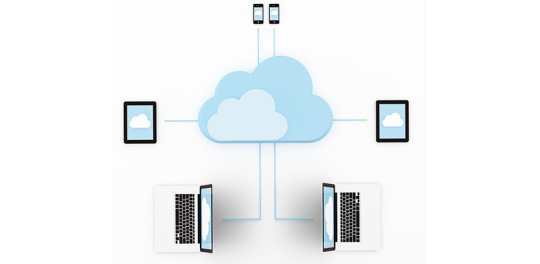
Cloud Computing is the most interesting and evolving topic in computing in the recent decade. The concept of storing data or accessing software from another computer that you are not aware of seems to be confusing to many users. Most the people/organizations that use cloud computing on their daily basis claim that they do not understand the subject of cloud computing. But the concept of cloud computing is not as confusing as it sounds. Cloud Computing is a type of service where the computer resources are sent over a network. In simple words, the concept of cloud computing can be compared to the electricity supply that we daily use. We do not have to bother how the electricity is made and transported to our houses or we do not have to worry from where the electricity is coming from, all we do is just use it. The ideology behind the cloud computing is also the same: People/organizations can simply use it. This concept is a huge and major development of the decade in computing.
Cloud computing is a service that is provided to the user who can sit in one location and remotely access the data or software or program applications from another location. Usually, this process is done with the use of a web browser over a network i.e., in most cases over the internet. Nowadays browsers and the internet are easily usable on almost all the devices that people are using these days. If the user wants to access a file in his device and does not have the necessary software to access that file, then the user would take the help of cloud computing to access that file with the help of the internet.
Cloud computing provide over hundreds and thousands of services and one of the most used services of cloud computing is the cloud storage. All these services are accessible to the public throughout the globe and they do not require to have the software on their devices. The general public can access and utilize these services from the cloud with the help of the internet. These services will be free to an extent and then later the users will be billed for further usage. Few of the well-known cloud services that are drop box, Sugar Sync, Amazon Cloud Drive, Google Docs etc.
Finally, that the use of cloud services is not guaranteed let it be because of the technical problems or because the services go out of business. The example they have used is about the Mega upload, a service that was banned and closed by the government of U.S and the FBI for their illegal file sharing allegations. And due to this, they had to delete all the files in their storage and due to which the customers cannot get their files back from the storage.
Service Models Cloud Software as a Service Use the provider's applications running on a cloud infrastructure Accessible from various client devices through thin client interface such as a web browser Consumer does not manage or control the underlying cloud infrastructure including network, servers, operating systems, storage
Google Apps, Microsoft Office 365, Petrosoft, Onlive, GT Nexus, Marketo, Casengo, TradeCard, Rally Software, Salesforce, ExactTarget and CallidusCloud
Cloud Platform as a Service Cloud providers deliver a computing platform, typically including operating system, programming language execution environment, database, and web server Application developers can develop and run their software solutions on a cloud platform without the cost and complexity of buying and managing the underlying hardware and software layers
AWS Elastic Beanstalk, Cloud Foundry, Heroku, Force.com, Engine Yard, Mendix, OpenShift, Google App Engine, AppScale, Windows Azure Cloud Services, OrangeScape and Jelastic.
Cloud Infrastructure as a Service Cloud provider offers processing, storage, networks, and other fundamental computing resources Consumer is able to deploy and run arbitrary software, which can include operating systems and applications Amazon EC2, Google Compute Engine, HP Cloud, Joyent, Linode, NaviSite, Rackspace, Windows Azure, ReadySpace Cloud Services, and Internap Agile
Deployment Models Private Cloud: Cloud infrastructure is operated solely for an organization Community Cloud : Shared by several organizations and supports a specific community that has shared concerns Public Cloud: Cloud infrastructure is made available to the general public Hybrid Cloud: Cloud infrastructure is a composition of two or more clouds
Advantages of Cloud Computing • Improved performance • Better performance for large programs • Unlimited storage capacity and computing power • Reduced software costs • Universal document access • Just computer with internet connection is required • Instant software updates • No need to pay for or download an upgrade
Disadvantages of Cloud Computing • Requires a constant Internet connection • Does not work well with low-speed connections • Even with a fast connection, web-based applications can sometimes be slower than accessing a similar software program on your desktop PC • Everything about the program, from the interface to the current document, has to be sent back and forth from your computer to the computers in the cloud
About Rang Technologies: Headquartered in New Jersey, Rang Technologies has dedicated over a decade delivering innovative solutions and best talent to help businesses get the most out of the latest technologies in their digital transformation journey. Read More...
#CloudComputing#CloudTech#HybridCloud#ArtificialIntelligence#MachineLearning#Rangtechnologies#Ranghealthcare#Ranglifesciences
9 notes
·
View notes
Text
Why XfilesPro For Salesforce File Management?
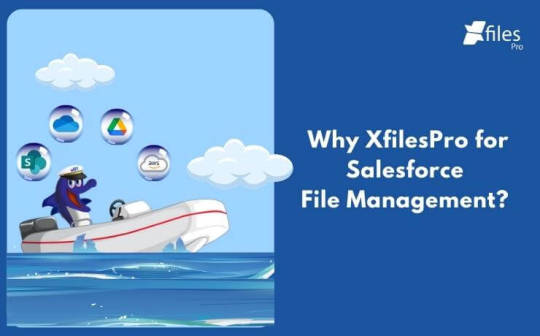
When facing any challenges related to file management in Salesforce, AppExchange is the first place you will reach out to. You will search for the best ‘file management’ solution in the biggest enterprise cloud marketplace. We can tell beyond a shadow of a doubt that XfilesPro will be the first result that comes in the search. Similarly, if you conduct Google research for the same, you will the name XfilesPro appears on the first page. Read More
4 notes
·
View notes
Text
Leveraging Technology for Commercial Loan Brokering Success!
Introduction:
In today’s digital age, technology plays a crucial role in streamlining processes, enhancing efficiency, and driving success in commercial loan brokering. From client management to deal structuring and market analysis, there are numerous technology tools and software solutions available to help commercial loan brokers succeed. This article explores some of the best technology tools and software for commercial loan brokers and how they can be leveraged to improve productivity, client service, and overall business performance. 1. Client Relationship Management (CRM) Systems:
CRM systems are essential for managing client interactions, tracking leads, and organizing communication. These platforms allow brokers to maintain a centralized database of client information, streamline communication, and track the progress of deals.
Examples: Salesforce, HubSpot, Zoho CRM.
Benefits: Improved client engagement, efficient lead management, automated follow-ups. 2. Loan Origination Software:
Loan origination software streamlines the loan application process, from initial application submission to underwriting and approval. These platforms often include features such as document management, automated workflows, and compliance tracking.
Examples: Encompass, Calyx Point, LendingPad.
Benefits: Faster loan processing, reduced paperwork, enhanced compliance. 3. Financial Analysis Tools:
Financial analysis tools help brokers evaluate the financial health of potential borrowers and assess the viability of loan proposals. These tools typically include features for financial statement analysis, ratio calculation, and risk assessment.
Examples: Riskalyze, Sageworks, Finsight.
Benefits: Accurate risk assessment, informed decision-making, enhanced due diligence. 4. Market Research Platforms:
Market research platforms provide access to data and insights on commercial real estate markets, property trends, and industry news. Brokers can use these platforms to stay informed about market conditions, identify investment opportunities, and advise clients accordingly.
Examples: CoStar, Reonomy, Real Capital Analytics.
Benefits: Comprehensive market analysis, property valuations, investment insights. 5. Document Management Systems:
Document management systems help brokers organize, store, and share documents securely. These platforms streamline document workflows, ensure compliance with regulations, and facilitate collaboration with clients and partners.
Examples: DocuSign, Dropbox Business, SharePoint.
Benefits: Secure document storage, streamlined workflows, improved collaboration. 6. Communication and Collaboration Tools:
Communication and collaboration tools enable brokers to connect with clients, lenders, and other stakeholders efficiently. These tools often include features such as video conferencing, instant messaging, and file sharing.
Examples: Zoom, Microsoft Teams, Slack.
Benefits: Seamless communication, virtual meetings, real-time collaboration. 7. Analytics and Reporting Software:
Analytics and reporting software help brokers track key performance metrics, monitor deal pipelines, and generate insights to drive business decisions. These platforms often offer customizable dashboards and reports to visualize data effectively.
Examples: Tableau, Power BI, Google Analytics.
Benefits: Data-driven decision-making, performance tracking, actionable insights.
Conclusion:
Leveraging technology is essential for commercial loan brokers to stay competitive, streamline processes, and deliver exceptional service to clients. By adopting the right technology tools and software solutions, brokers can improve efficiency, reduce administrative burdens, and focus more on building client relationships and closing deals. Whether it’s CRM systems for client management, financial analysis tools for risk assessment, or market research platforms for industry insights, investing in technology is key to success in commercial loan brokering.

#CommercialLoanBrokering#LoanOrigination#ClientRelationshipManagement#FinancialAnalysis#MarketResearch#DocumentManagement#TechInFinance#CRMforBrokers#BusinessEfficiency#RealEstateTech#TechDrivenFinance#DigitalTransformation#LoanBrokeringTools#FinTechSolutions#BusinessGrowth
1 note
·
View note
Text
AI Enterprise Search and Machine Learning: A Perfect Pair for Smart Data Discovery
In today’s fast-paced digital landscape, businesses are generating an unprecedented amount of data. From emails and documents to chat conversations and project files, employees often struggle to find the right information at the right time. The traditional methods of searching through folders, databases, and multiple platforms are not only time-consuming but also inefficient. Enter AI-powered enterprise search—an advanced solution designed to revolutionize the way organizations access and manage information.

The Growing Need for Smarter Search Solutions
The modern workplace is evolving rapidly, with remote work, hybrid teams, and cross-functional collaboration becoming the norm. As organizations scale, the volume of data expands, making it increasingly difficult to locate critical information efficiently. According to McKinsey, employees spend an average of 1.8 hours every day searching for information—a staggering loss of productivity. AI enterprise search solutions address this challenge by enabling smarter, faster, and more accurate information retrieval.
Key Challenges in Traditional Enterprise Search
Data Silos: Information is scattered across different departments and platforms, making it hard to retrieve relevant data.
Time Consumption: Manual searches slow down workflow and impact overall productivity.
Relevance Issues: Traditional keyword-based searches often return irrelevant results, requiring employees to sift through excessive data.
Security Concerns: Ensuring that sensitive data remains protected while allowing authorized access can be complex.
How AI Enterprise Search Transforms Collaboration
AI-driven enterprise search engines leverage machine learning (ML), natural language processing (NLP), and deep learning algorithms to enhance search capabilities. These technologies help businesses unlock the true potential of their data and foster smarter collaboration in several ways:
1. Improved Search Relevance with NLP
AI-powered search engines understand the context behind search queries, rather than relying solely on keywords. NLP allows these systems to interpret natural language, synonyms, and user intent, ensuring that employees receive the most relevant results instantly.
2. Unified Search Across Multiple Platforms
Enterprise search solutions integrate seamlessly with various platforms, such as Google Drive, Microsoft 365, Slack, Salesforce, and internal databases. This unified approach eliminates data silos, enabling teams to find information across different systems without switching between applications.
3. Personalized and Context-Aware Results
AI enterprise search engines learn from user behavior and past interactions, providing personalized results tailored to individual employees. This contextual awareness reduces search time and enhances productivity by surfacing the most relevant data first.
4. Smart Recommendations and Insights
Advanced AI search tools don’t just retrieve information—they provide intelligent recommendations based on user activity, ongoing projects, and frequently accessed files. This proactive approach enhances collaboration by suggesting relevant documents, reports, and team members for a given task.
5. Enhanced Security and Access Control
AI enterprise search incorporates robust security features, ensuring compliance with organizational policies and industry regulations. Role-based access control (RBAC) and encryption protocols prevent unauthorized users from accessing sensitive data while allowing seamless collaboration among authorized personnel.
6. Conversational AI and Voice Search
With the rise of AI-powered assistants, voice-activated search is becoming a game-changer in enterprise environments. Employees can quickly find information using voice commands, improving accessibility and efficiency, especially in hands-free or mobile scenarios.
The Business Impact of AI Enterprise Search
Adopting AI-driven enterprise search solutions leads to measurable business benefits, including:
Increased Productivity: Employees spend less time searching for data and more time on strategic tasks.
Better Decision-Making: Quick access to relevant insights allows for informed decision-making.
Enhanced Collaboration: Teams can effortlessly share and retrieve information, breaking down communication barriers.
Reduced Operational Costs: Streamlined workflows and automation reduce redundant work, saving time and resources.
The Future of AI Enterprise Search
As AI technology continues to evolve, enterprise search will become even more powerful. Some key trends shaping the future include:
Generative AI for Search Assistance: AI chatbots and virtual assistants will provide conversational search experiences, summarizing documents and answering complex queries.
Predictive Search Capabilities: AI will anticipate user needs based on historical search behavior and proactively surface relevant information before it’s even requested.
Deeper Integration with Workplace Apps: Enterprise search will seamlessly integrate with collaboration tools, project management software, and CRM systems for a holistic experience.
Greater Focus on AI Ethics and Bias Reduction: Future AI search models will prioritize transparency, fairness, and unbiased information retrieval to ensure ethical AI practices.
Conclusion
AI enterprise search is transforming the way businesses operate, making information more accessible, relevant, and secure. By leveraging AI-driven search capabilities, organizations can enhance productivity, improve collaboration, and gain a competitive edge in the digital era. As AI technology continues to advance, the future of work will be defined by smarter, more intuitive, and seamless information retrieval systems. Companies that embrace AI-powered enterprise search today will be better positioned to navigate the complexities of tomorrow’s workplace.
0 notes
Text
The Top Tools You Need to Boost Workflow Efficiency
Improving workflow efficiency is crucial for businesses to stay competitive and productive. The right tools can automate tasks, improve collaboration, and streamline processes. Here are the top tools you need to enhance workflow efficiency and maximize productivity.
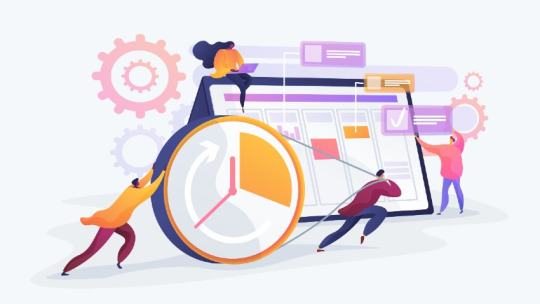
1. Project Management Software
A well-structured project management tool helps teams organize tasks, set deadlines, and track progress. Platforms like Asana, Trello, and Monday.com provide a centralized workspace where teams can collaborate in real time, ensuring projects stay on track without delays.
2. Task Automation Tools
Repetitive manual tasks slow down workflow efficiency. Automation tools like Zapier and Microsoft Power Automate help integrate applications and automate routine processes, reducing errors and saving time. Automating approvals, data entry, and notifications enhances overall efficiency.
3. Time Tracking Software
Time management is critical for productivity. Time-tracking tools like Toggl and Clockify allow teams to monitor how time is spent on tasks, helping businesses identify inefficiencies and improve workload distribution. Tracking work hours also ensures accurate billing and payroll management.
4. Collaboration and Communication Platforms
Effective communication reduces misunderstandings and enhances teamwork. Tools like Slack, Microsoft Teams, and Google Workspace enable instant messaging, file sharing, and virtual meetings, ensuring seamless collaboration regardless of location.
5. Document Management Systems
Handling large volumes of documents manually can be time-consuming. Cloud-based document management solutions like Google Drive and Dropbox enable secure file storage, easy access, and version control. These tools improve document organization and minimize time spent searching for files.
6. Workflow Automation Software
For businesses dealing with approvals, task delegation, and process management, workflow automation tools like Cflow and Kissflow simplify operations. These tools provide predefined workflows, eliminating bottlenecks and ensuring smoother business processes.
7. Customer Relationship Management (CRM) Software
For businesses handling sales and customer interactions, CRM tools like Salesforce and HubSpot help manage customer data, track interactions, and automate follow-ups. This leads to improved customer engagement and sales efficiency.
8. AI-Powered Chatbots and Virtual Assistants
AI-driven tools like ChatGPT and Drift automate responses, schedule meetings, and assist in customer support. Implementing AI reduces response time and enhances overall operational efficiency.
9. Data Analytics and Reporting Tools
Making data-driven decisions is key to optimizing workflows. Tools like Tableau and Google Analytics provide insights into business performance, helping leaders identify areas for improvement and allocate resources effectively.
10. Cloud-Based Accounting Software
Managing finances efficiently is essential for workflow optimization. Cloud-based accounting tools like QuickBooks and Xero simplify expense tracking, invoicing, and financial reporting, reducing manual errors and saving time.
youtube
Conclusion
Choosing the right tools can significantly enhance workflow efficiency, reduce manual effort, and improve team collaboration. By implementing these solutions, businesses can streamline operations, boost productivity, and achieve better results.
SITES WE SUPPORT
Workflow Expenditure - Wix
SOCIAL LINKS Facebook Twitter LinkedIn
0 notes
Text
Salesforce DevOps Online Training | Salesforce DevOps Course
What Challenges Does Copado Solve in Salesforce DevOps Pipelines?
Salesforce DevOps Training world of Salesforce development, implementing effective DevOps practices is essential for delivering high-quality applications efficiently. However, teams often encounter several challenges unique to the Salesforce ecosystem. Copado, a leading Salesforce-native DevOps platform, offers solutions to these challenges, streamlining development and deployment processes.
Challenges in Salesforce DevOps Pipelines
Siloed Development and Operations Teams
Traditionally, development and operations teams in Salesforce environments operate in silos, leading to fragmented workflows and hindered collaboration. This disconnect can cause misaligned priorities, deployment delays, and increased error ratesSalesforce DevOps Course.

Complexity with Salesforce Metadata
Salesforce's metadata-driven architecture presents challenges such as:
Component behavior split across multiple files (e.g., Profiles, Layouts).
Unsupported metadata types.
Inconsistent modification timestamps for certain metadata (e.g., Value Sets).
Numerous manual steps required in deployments.
These complexities can lead to deployment errors and increased manual effort.
Version Control and Source Code Management
Many Salesforce teams are not accustomed to version control systems, leading to challenges such as:
Complexity with merges and back-merges.
Conflict resolution in large objects and Profiles during heavy-duty merges.
This can result in difficulties tracking changes, collaborating effectively, Salesforce DevOps Certification and maintaining code integrity.
Continuous Integration and Deployment (CI/CD)
Implementing effective CI/CD practices in Salesforce development can be daunting due to:
Complex customizations and configurations.
Challenges in ensuring pipeline stability and reliability.
Without proper CI/CD processes, teams may face delays in identifying bugs, lower confidence in code changes, and a higher risk of regression issues.
Test Automation and Code Quality
Ensuring high code quality and implementing comprehensive test automation are critical yet challenging aspects of Salesforce DevOps. Manual testing can be time-consuming and error-prone, while maintaining code quality becomes more difficult as projects grow in size and complexity.
How Copado Addresses These Challenges
Enhancing Collaboration Between Teams
Salesforce DevOps with Copado Training fosters collaboration by providing a unified platform where development and operations teams can work together seamlessly. Features like user stories, pipelines, and automated deployments ensure that all stakeholders are aligned, reducing silos and improving communication.
Simplifying Metadata Management
Copado simplifies metadata management by:
Providing a comprehensive view of all metadata components.
Automating the retrieval and deployment of metadata.
Handling complex dependencies and unsupported metadata types.
This reduces manual steps and minimizes errors during deployments.
Streamlining Version Control
Copado integrates with version control systems like Git, offering:
User-friendly interfaces for managing branches and merges.
Automated conflict detection and resolution assistance.
Visualization tools to track changes and history.
This makes version control more accessible to Salesforce teams, enhancing collaboration and code integrity.
Implementing Robust CI/CD Pipelines
Copado enables the creation of robust CI/CD pipelines by:
Automating builds and deployments across multiple environments.
Integrating automated testing to catch issues early.
Providing rollback mechanisms to ensure stability.
This accelerates release cycles and ensures high-quality deployments.
Enhancing Test Automation and Code Quality
Copado improves test automation and code quality by:
Integrating with testing frameworks to automate test execution.
Enforcing code quality checks and best practices.
Providing dashboards to monitor test results and code metrics.
This ensures that only high-quality code reaches production, reducing defects and technical debt.
Conclusion
Copado addresses the unique challenges of Salesforce DevOps by enhancing collaboration, simplifying metadata management, streamlining version control, implementing robust CI/CD pipelines, and improving test automation and code quality. By leveraging Copado, organizations can achieve more efficient, reliable, and scalable Salesforce development and deployment processes.
Visualpath is the Leading and Best Software Online Training Institute in Hyderabad. Avail complete Salesforce DevOps Course Worldwide. You will get the best course at an affordable cost.
Attend Free Demo
Call on - +91-9989971070.
WhatsApp: https://www.whatsapp.com/catalog/919989971070/
Visit: https://www.visualpath.in/online-salesforce-devops-training.html
Visit Blog: https://salesforcedevopscourseonlinetraining.blogspot.com/
#Salesforce DevOps Training#Salesforce DevOps Course#Salesforce DevOps Certification#Salesforce DevOps Online Training#Salesforce DevOps Training In Hyderabad#Salesforce DevOps With Copado Training#Salesforce DevOps Online Training Hyderabad#Salesforce DevOps Online Courses
0 notes
Text
What Makes Most Dope the Best Roofing CRM?
In today’s competitive roofing industry, having the right tools to manage your business can be the difference between thriving and merely surviving. That’s where Most Dope comes in—an all-in-one solution that truly redefines what it means to be the best roofing CRM. Whether you’re juggling leads, managing projects, or communicating with your team and customers, Most Dope has you covered.
Why Most Dope Is the Best Roofing CRM
When we say “best roofing CRM,” we don’t just mean software that keeps your leads in a spreadsheet. Most Dope goes above and beyond to automate, optimize, and simplify every aspect of your roofing business.
1. Tailored Specifically for Roofers
Unlike generic CRM platforms like Salesforce or HubSpot, Most Dope was designed with roofing professionals in mind. From lead tracking to job scheduling, every feature is crafted to meet the unique needs of roofing companies.
Custom workflows for roofing projects.
Tools for tracking demo percentages and close rates.
Roofing-specific automation templates.
2. All-in-One Platform
Many roofing businesses rely on multiple tools like JobNimbus, Podium, Canva, and Zapier to manage different parts of their operations. Most Dope eliminates the need for all these tools by combining their functionalities into one seamless platform.
With Most Dope, you get:
A powerful CRM.
Integrated communication tools (calls, texts, emails).
Built-in design features for proposals and marketing.
Smart automations to save time and reduce errors.
3. AI-Powered Insights
Most Dope leverages advanced artificial intelligence to help roofing companies work smarter, not harder. From automated follow-ups to customer behavior insights, our AI tools take the guesswork out of managing your business.
AI-driven lead scoring to prioritize high-value customers.
Automated follow-ups that nurture leads until they’re ready to close.
ChatGPT-like assistance for generating quick, professional responses.

4. Effortless Team Collaboration
Gone are the days of juggling Slack, GroupMe, or other team messaging apps. Most Dope centralizes team communication, so everyone—from sales reps to project managers—is on the same page.
Shared dashboards for real-time updates.
Task assignments linked directly to jobs.
Centralized file storage for photos, documents, and more.
5. Superior Customer Communication
Customer satisfaction is everything in the roofing business, and Most Dope makes it easy to keep your clients in the loop. Whether it’s sending appointment reminders, sharing project updates, or answering questions, our CRM simplifies it all.
Centralized communication for calls, texts, and emails.
Automated customer updates on project status.
Review collection to boost your online reputation.
6. Built-In Marketing and Design Tools
Forget Canva and Hootsuite. Most Dope includes built-in tools to create marketing materials and manage social media campaigns—all tailored to your roofing business.
Proposal templates designed to close deals.
Social media post scheduling.
AI-assisted designs to streamline your marketing efforts.
7. Automation That Saves Time
Repetitive tasks like scheduling appointments, following up with leads, or sending reminders can eat up your day. Most Dope automates these processes, freeing up your time to focus on what matters most: growing your business.
Pre-built automations for scheduling, lead nurturing, and reminders.
Advanced triggers that respond to customer actions in real-time.
Seamless integration of automation into every part of your business.

8. Proven Results
Don’t just take our word for it—Most Dope has a track record of delivering impressive results for roofing companies.
Increased close rates with AI-powered insights.
Higher revenue through streamlined processes and lead management.
Reduced overhead by eliminating unnecessary tools and subscriptions.
Why Settle for Less When You Can Have the Best?
If you’re tired of struggling with clunky, generic CRMs that don’t meet the unique needs of your roofing business, it’s time to make the switch. Most Dope isn’t just another CRM—it’s the best roofing CRM designed to help you win more leads, close more deals, and grow your revenue.
Ready to Experience the Best Roofing CRM?
Discover how Most Dope can transform your roofing business today. Schedule a free demo and see why so many roofing professionals are making the switch.
1 note
·
View note
Text
#best file management solution for Salesforce#Big files in Salesforce#Salesforce file limit#Salesforce file management#Salesforce file storage management
0 notes
Text
Integrating Salesforce with SharePoint: Enhance Collaboration & Efficiency
Integrating Salesforce with SharePoint enhances document management and collaboration. As a Top Salesforce Partner in USA, we help streamline workflows, ensure secure file sharing, and reduce duplication. Whether using native connectors, third-party tools, or custom solutions, this integration optimizes your system's performance and boosts productivity, making critical documents easily accessible and improving team efficiency.
0 notes
Text
SAAS Product Development: A Step-by-Step Approach for Entrepreneurs.
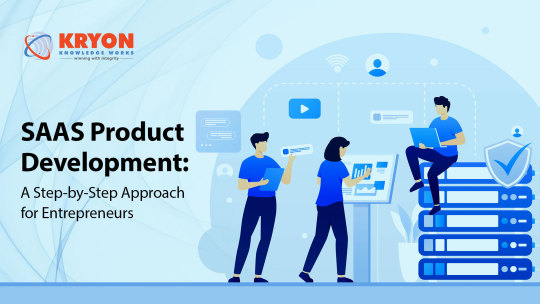
Introduction:
The global Software as a Service (SaaS) market is projected to grow from USD 317.55 billion in 2024 to USD 1,228.87 billion by 2032, with a CAGR of 18.4%. This growth emphasizes the importance of SaaS product development for businesses to stay competitive. Key factors include:
Adoption of cloud-based solutions offering scalability, flexibility, and cost-effectiveness.
Integration of advanced technologies like AI and ML to improve efficiency and insights.
Centralized data analytics enabling better decision-making and performance optimization.
Strategic partnerships expanding SaaS offerings, such as IBM’s collaboration with AWS. Additionally, the rise of hybrid work environments has made SaaS tools essential for project management, communication, and HR needs.
What you’ll learn in this article:
· What are the steps involved in the SAAS product development?
· Opportunities and threats in SAAS product development for entrepreneurs.
· What are the common Pitfalls in SaaS Product Development, and how can we overcome them?
· Team consideration in SAAS product development?
· Factors That Affect the Cost of SaaS Product Development
· Tips for Building Successful SaaS Products.
Importance of SAAS in Business development:
SaaS plays a key role in helping businesses grow by providing easy access to software tools and solutions. It removes the need for expensive infrastructure, reduces maintenance work, and ensures automatic updates without extra effort.
SaaS is flexible and can grow or shrink with business needs, making it suitable for startups, small companies, and large organizations. From managing projects to improving customer relationships, SaaS solutions support various business tasks, helping companies work smarter, save time, and achieve their goals faster.
What is SaaS and Its benefits?
Software-as-a-Service (SaaS) is a cloud-based way of delivering software to users over the Internet. Instead of buying software and installing it on a device, users subscribe to the software and access it online from any compatible device. The actual software runs on cloud servers, which are managed by the SaaS provider and can be located far from the user’s location.
With SaaS, users don’t need to worry about maintaining the software or managing the infrastructure it runs on. The SaaS provider takes care of updates, security, and maintenance. Users simply focus on using the software for their needs. SaaS typically follows a subscription model, where users pay monthly or yearly fees or a pay-as-you-use pricing structure. This makes SaaS more affordable and flexible compared to traditional one-time purchases.
Examples of SaaS products include Google Workspace (formerly G Suite) for email, document creation, and collaboration; Slack for team communication and messaging; Salesforce for customer relationship management (CRM); Zoom for video conferencing and online meetings; and Dropbox for cloud storage and file sharing. These tools allow users to access powerful features through an internet connection without worrying about installation, updates, or maintenance, making them popular choices for businesses of all sizes.
Why should businesses need the SAAS product?
Reduces Time to Market: SaaS solutions are often quicker to implement since they don’t require extensive setup or installation of infrastructure. This allows businesses to launch new products or services faster.
Easy Integration & Scalability: SaaS products are designed to integrate seamlessly with existing systems, making it easier to adopt new tools without disrupting operations. Additionally, SaaS platforms are highly scalable, enabling businesses to adjust their usage as needs grow or change.
Super Secure: SaaS providers invest heavily in security measures like data encryption, regular updates, and compliance with regulations, ensuring that sensitive business data is protected.
Cost-Effectiveness: SaaS operates on a subscription model, eliminating the need for upfront capital expenditures. Businesses pay only for what they use, reducing overall costs and improving resource allocation.
Improved Cash Flow: By shifting to a subscription model, SaaS helps improve cash flow by providing predictable, manageable expenses instead of large, one-time software purchases and ongoing maintenance costs.
What are the steps involved in the SAAS product development?
Idea Validation
Validating your SaaS idea is essential to ensure it meets market needs. It helps reduce risks by confirming that your product solves real pain points for users. Methods like market research, identifying pain points, and understanding user needs allow you to test the demand before development begins.
Market Research
Conduct thorough market research to define target customers, understand their pain points, and assess competitors. This research will help you identify unique selling points and determine the viability of your product.
Product Planning
Creating a Product Concept and Roadmap: Establishing a clear product vision and roadmap guides development and keeps the project on track.
Defining Features and Functionalities: Focus on essential features that solve user problems, ensuring the product provides real value.
Establishing Unique Value Proposition (UVP): Highlight what sets your SaaS apart from competitors, helping you stand out in the market.
Technology Stack Selection
Choosing the right technologies ensures your SaaS product runs efficiently and securely.
Choosing the Right Technologies for Development: Select tools and platforms that align with your product’s needs and goals.
Overview of Popular SaaS Technologies: Commonly used SaaS technologies include cloud computing, APIs, and databases.
Considerations for Scalability and Security: Ensure your technology stack supports growth and keeps user data secure.
Design and Prototyping
A good design improves user experience and makes your SaaS product more effective. User-centered design focuses on creating a product that meets user needs and is easy to navigate, ensuring a seamless and intuitive experience. Creating wireframes and mockups helps visualize the product and align design elements with user expectations. A smooth and user-friendly UX keeps users engaged and satisfied, ultimately enhancing the overall effectiveness of the SaaS product.
Development Process
Choosing the right development approach ensures your SaaS product is built efficiently. Building a Minimum Viable Product (MVP): An MVP helps test key features, gather user feedback, and validate the core idea before scaling up. Iterative Development and Feedback Loops: Continuous feedback ensures the product evolves based on real user needs, helping improve and refine the final product.
Testing and Quality Assurance
Conduct comprehensive testing to identify and resolve bugs, usability issues, and security vulnerabilities. Regularly perform quality assurance checks to maintain the highest standards throughout the product life cycle.
Launch Strategy
A well-planned launch ensures your SaaS product gets off to a strong start.
Preparing for a Successful Product Launch: Clear planning, preparation, and marketing strategies ensure a smooth go-to-market.
Marketing Strategies for SaaS Products: Use digital marketing, content, and partnerships to reach your target audience.
Gathering Initial User Feedback Post-launch: Collecting feedback helps improve the product and build long-term customer engagement.
Maintenance and Scaling
Ongoing Maintenance Best Practices: Keep your product updated, secure, and optimized to avoid performance issues.
Strategies for Scaling Your SaaS Product: Plan for growth by adding features, enhancing user experience, and increasing capacity.
Importance of Customer Support and Engagement: Providing excellent support helps retain users and ensure satisfaction.
Financial Planning and Budgeting
Proper financial planning ensures your SaaS project stays within budget and meets goals.
Estimating Costs for SaaS Development: Budgeting for development, marketing, and ongoing expenses ensures financial stability.
Funding Options for SaaS Startups: Options like venture capital, grants, or crowdfunding can support your SaaS business.
Pricing Models: Subscription, Freemium, etc.: Choosing the right pricing model (like subscription or freemium) helps ensure sustainable revenue.
Opportunities and threats in SAAS product development for entrepreneurs.
Opportunities:
Artificial Intelligence & Machine Learning (AI/ML) Integration
Predictive Analytics: Building SaaS solutions with AI-driven insights to enhance data-driven decision-making.
Automation & Intelligent Workflows: Developing SaaS products that automate tasks, offer personalized recommendations, and optimize workflows.
Natural Language Processing (NLP): Creating tools for chatbots, voice assistants, and AI-based customer support.
IoT-Enabled SaaS Platforms
Real-Time Data Analytics: Building IoT-enabled SaaS solutions that provide real-time data for industries like manufacturing, logistics, and smart cities.
Asset Management & Tracking: Developing SaaS products that use IoT data to monitor and manage connected devices.
Micro-SaaS Platforms
Specialized SaaS Products: Developing small, focused SaaS solutions for specific tasks (e.g., task management, billing, project tracking, etc.).
Low-Cost SaaS Models: Offering niche products with simplified features at competitive pricing to target small or mid-sized businesses.
Subscription & Flexible Pricing Models
Usage-Based Pricing: Building SaaS products that offer pay-per-use models, scalable subscriptions, or tiered pricing.
Freemium Models: Creating SaaS products with free basic tiers and premium features for upselling.
Self-Service & Customer Onboarding Tools
Simplified User Experiences: Building SaaS products with intuitive interfaces, self-service capabilities, and onboarding wizards.
Support & Community Platforms: Developing SaaS solutions with knowledge bases, forums, and automated customer support.
Threats:
Data Security & Privacy Risks
Data Breaches & Cybersecurity Threats: As SaaS solutions store sensitive user data, cybersecurity threats such as data breaches, ransomware attacks, and unauthorized access can be significant risks.
Compliance Risks: Ensuring compliance with regulations like GDPR, HIPAA, or PCI-DSS can be complex and costly, posing legal and reputational risks.
Intense Market Competition
Over-saturation: The SaaS market is highly competitive, with numerous players offering similar solutions, making it difficult for new entrants to stand out.
Price Pressure: Competitive pricing models often lead to margin pressure, especially if multiple vendors offer similar features at lower prices.
High Development & Operational Costs
Scaling Costs: Building, maintaining, and scaling SaaS products requires significant upfront investment in infrastructure, development, and cloud resources.
Resource Constraints: Recruiting skilled developers and maintaining a robust tech stack may increase operational costs, affecting profitability.
Dependency on Third-Party Services
Service Downtime or Disruptions: SaaS products often rely on third-party services (cloud providers, APIs, payment gateways), and disruptions or outages from these partners can negatively impact the SaaS product.
Vendor Lock-In: Over-dependence on specific third-party tools or platforms may lead to vendor lock-in, reducing flexibility in switching providers.
What are the common Pitfalls in SaaS Product Development?
Overcomplicating Features
Avoid overwhelming users with too many features. Focus on providing core functionality that solves key problems. Simplifying your product improves the user experience and makes it easier for customers to adopt and use.
Solution: Focus on delivering core functionality that solves key user problems.
Steps to Overcome:
· Prioritize Essential Features: Identify what features are truly necessary and remove unnecessary ones.
· User Feedback: Gather feedback from potential users to understand what they value most.
· Simplicity & Usability: Ensure the product is easy to use with an intuitive interface.
Insufficient Market Research
Don’t skip market research. Understand your target audience and their needs. Validate your product idea, identify what sets you apart from competitors, and ensure your product addresses customer pain points effectively.
Solution: Conduct thorough market research to ensure your product meets user needs.
Steps to Overcome:
· Understand Target Audience: Gather insights into your audience’s pain points and preferences.
· Competitor Analysis: Study competitors to identify gaps and opportunities.
· Validate Your Idea: Use surveys, interviews, and feedback loops to validate your product concept before development.
Factors Affecting the Cost of SaaS Product Development.
1.Complexity & Features
More Complex Products: The more features and functionalities a SaaS product has, the higher the development cost.
Core vs. Advanced Features: Simple SaaS products with fewer features cost less to develop, while SaaS products with advanced features like AI, integrations, or extensive customization require more development effort and budget.
2. Development Team & Expertise
Skilled Developers: SaaS development requires specialized expertise in areas like cloud computing, APIs, front-end, and back-end development.
Geography: Development teams from regions with lower labor costs (e.g., India, Eastern Europe) generally offer more affordable services compared to regions with higher costs (e.g., North America, Western Europe).
3. Technology Stack & Infrastructure
Cloud Infrastructure Costs: SaaS products often rely on cloud-based infrastructure (like AWS, Azure, or Google Cloud), which incurs ongoing costs for storage, bandwidth, and server maintenance.
Choosing Tech Stack: The choice of technology (e.g., front-end frameworks, back-end languages, databases) can influence development complexity and costs.
4. Third-Party Tools & Integrations
APIs & Integrations: Building SaaS products that require third-party integrations or APIs (CRM, payment gateways, etc.) adds to development time and costs.
Licensing Fees: Costs associated with third-party software, libraries, or tools used in development.
5. Design & User Experience (UX)
UI/UX Design Complexity: Developing an intuitive and user-friendly interface adds to the development cost, especially if customization or brand-specific design is required.
Customization: More customized designs or features tailored to specific user needs increase development effort.
6. Security & Compliance Requirements
Data Security & Compliance: SaaS products that handle sensitive data (e.g., healthcare, finance) must comply with regulatory standards (e.g., GDPR, HIPAA). Meeting these compliance requirements increases the cost.
7. Team Size & Project Duration
Project Size: Larger, more ambitious SaaS projects require bigger teams, leading to higher costs.
Timeline: A tight deadline may require more resources, leading to higher costs for quicker delivery.
Team consideration in SAAS product development?
Roles and Responsibilities
Developing a successful SaaS product requires assembling the right team, each with distinct roles that contribute to the overall success. A Product Manager (PM) ensures the product vision aligns with business goals by gathering requirements, prioritizing tasks, and coordinating between teams. Developers (front-end, back-end, full-stack) build core functionality, focusing on scalable and secure code. UI/UX designers create user-friendly interfaces that enhance the product’s usability. QA/Testers ensure the product is bug-free, and performing well across devices. DevOps engineers manage cloud services, optimizing deployment and performance. Data Engineers and Analysts handle data pipelines, providing insights for better decision-making. The Marketing and Growth team drives user acquisition and retention through effective strategies. Finally, the Support and Customer Success team ensures customer satisfaction, collecting feedback to improve the product.
Team Collaboration & Communication
Agile methodologies are key for SaaS product development, promoting iterative development, continuous feedback, and improved collaboration. Shared vision and clear goals ensure that all team members stay aligned. Regular meetings like daily stand-ups and sprint reviews foster effective communication and accountability.
Tool & Infrastructure Consideration
Effective project management relies on tools such as Jira, Trello, Slack, and Confluence, which enhance team communication and productivity. Cloud platforms like AWS, Azure, and GCP are essential for deploying and managing SaaS infrastructure. Git-based tools like GitHub ensure smooth version control and code collaboration.
Tips for Building Successful SaaS Products
1. Understand Your Target Market & Validate Your Idea
Level 1: Research & Define the Problem: Start by conducting in-depth research to understand your target audience, their pain points, and the industry trends. Identify what challenges your SaaS product aims to solve. Level 2: Validate Your Idea: Use methods like customer surveys, interviews, and feedback to validate the demand for your product. Build a minimum viable product (MVP) to test the concept in real-world conditions, ensuring there’s genuine interest.
2. Prioritize Simplicity & Core Functionality
Level 1: Identify Core Features: Focus on delivering the essential functionality that addresses the primary needs of your users. Avoid feature bloat that can overwhelm users and dilute the product’s value. Level 2: Iterate Based on User Feedback: After launching, continuously gather feedback, prioritize enhancements, and streamline the user experience to maintain simplicity and ensure usability.
3. Build for Scalability & Performance
Level 1: Plan for Future Growth: Design your SaaS product with scalability in mind, considering increasing user demand and data loads. Use cloud-based infrastructure to ensure your product performs efficiently under growth conditions. Level 2: Optimize Infrastructure & Performance: Invest in scalable cloud services (like AWS, Azure) and monitor performance regularly. Ensure the product can handle traffic spikes, ensuring reliability and uptime.
4. Invest in Customer Support & Retention
Level 1: Build a Support System: Offer exceptional customer support to address issues and ensure customer satisfaction. Provide onboarding, training, and self-help resources to enhance user experience. Level 2: Focus on Retention & Feedback Loops: Use customer feedback to improve your product, address pain points, and implement features that enhance user satisfaction, driving long-term retention.
Steps to Choose the Right SaaS Application Development Company
1. Research and Identity Requirements
Start by clearly defining your SaaS application requirements. Outline the key features, functionalities, budget, timeline, and technical specifications you need.
Share Your Requirements: Provide detailed requirements regarding the scope of work, timeline, budget, and any specific technologies you need.
Shortlist Potential Companies: Research and identify reputable SaaS application development companies that align with your criteria, based on factors like experience, expertise, and client feedback.
2. Conduct a Thorough Evaluation
Engage in Research & Analysis: Review the company’s portfolio, case studies, and previous work to ensure they have relevant experience in SaaS application development.
Check Reviews & Testimonials: Look for client testimonials, ratings, and feedback on platforms like Clutch, G2, or Google Reviews to gauge their reliability and quality of work.
Evaluate Technical Expertise: Ensure the company has expertise in relevant technologies, such as cloud platforms (AWS, Azure, GCP), APIs, DevOps, and front-end/back-end development frameworks.
3. Engage and Shortlist Potential Companies
Request Proposals and Demo Sessions: Reach out to shortlisted companies and request detailed proposals or demos showcasing their capabilities and how they plan to meet your needs.
Discuss Technical Solutions: Engage in discussions with the development team to understand their approach to SaaS development, such as their development methodology, scalability, and security practices.
4. Build a Clear Plan and Setup the Team
Define Milestones & Deliverables: Establish clear project milestones, timelines, and deliverables to ensure accountability.
Team Setup: Collaborate with the company to define the team structure (developers, product managers, designers, QA engineers, etc.) that will work on your project. Ensure the team has the right skills and experience.
5. Proceed with Terms & Agreement
Set Clear Terms & Conditions: Define the terms of engagement, including pricing, payment schedules, intellectual property rights, and project timelines.
Legal Agreements: Ensure proper contracts are in place, covering confidentiality, ownership, and scope of work.
Review & Finalize: Once the terms are agreed upon, sign a formal agreement to ensure both parties are aligned on expectations and responsibilities.
From Beginning to End: Building Remarkable SaaS Products for Today’s Market
From start to finish, building successful SaaS products requires careful planning, diligent execution, and a commitment to continuous improvement. By understanding the significance of SaaS in today’s business world, following the steps involved in SaaS product development, and addressing common challenges, you can create a high-quality product that meets customer needs and drives business growth. Stay focused, adaptable, and customer-focused, and your SaaS product will be positioned for success in today’s competitive market. When you’re ready to take the next step, our Growth Accelerator program is here to help you turn your product into a thriving business.
#saas platform#technology#business strategy#business startups#entrepreneur#application#product development
1 note
·
View note
Text
The Best softwares to Keep Your Small Business Team Connected
Team members can no longer rely on one-on-one conversations with coworkers in today's modernising workplace, and sending important files or sharing every little detail via email—which can take a lot of time because of its protocol—to accomplish these tasks. Selecting communication softwares can be the finest choice because it enhances time management, team productivity, and collaboration in addition to communication.
Due to their inability to meet their needs and their perception that work chat platforms are too costly, small and microbusiness owners resort to social chat softwares. An unexpected pandemic sickness compelled some to employ them. However, some of the top products are able to offer high-quality services at a reasonable cost due of their subscription schemes.
The following are some of the most effective communication softwares for your business.
1. Troop Messenger
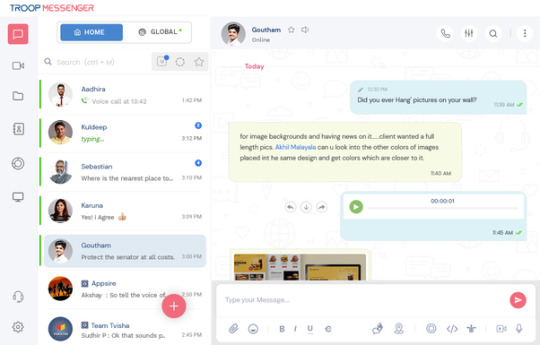
Troop Messenger is considered the best communication software, which can be used as a business messaging tool, work chat tool, and instant messaging tool for both office and remote work.
Troop Messenger shook the market quickly, and many businesses decided to use it after learning about its cutting-edge features, which might not be included in apps that are currently available or would probably be added to major application upgrades in the future.
The instrument is affordable and suitable for use in any field, and additional features were added as a result of Troop Messenger's extensive research. This safe and secure team texting application might be used for secret information communication between the military and NASA.
Features
Remote screen sharing and controlling
Join Now, allows the user to join the missed group audio or video call while ongoing
Burnout
Live Location Tracking
Jointly Code
Advanced Search Filters
Forkout
2. Microsoft Teams
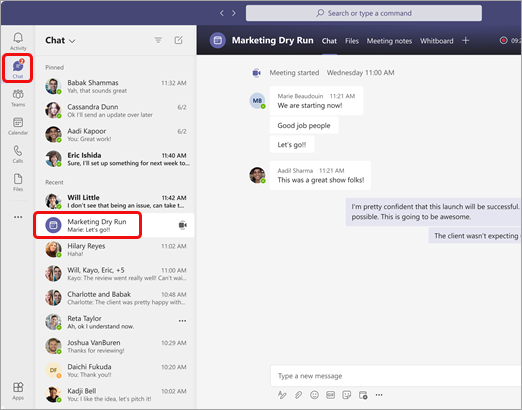
Office 365 plans can be accessed by users of Microsoft Teams, a proprietary internal communication software created by Microsoft and included in the Microsoft 365 product line. If you utilise more Microsoft apps at work, this is the right collaboration tool.
Features
Meeting Recordings
Screen sharing
All Microsoft 365 apps and services may be accessed with a single sign-on.
Cloud-based solution
100+ Participants capacity
3. Slack
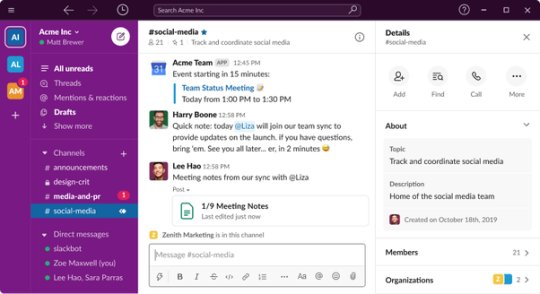
Slack Technologies, an American software business that created the exclusive communication software Slack, was purchased by Salesforce in 2021. Because of its price, startups might be interested in it, and it could be a helpful tool for communication at work. It is a better alternative to email services because of its corporate key management, two-factor authentication, data encryption, and other features.
Features
Files sharing
Voice and Video calls
File sharing
Apps & Integrations
Slack Connect
4. Flock

Flock is a well-integrated enterprise communication tool with Twitter, Google Calendar, Trello, Jira, Google Drive, GitHub, and so on, which helps your team save time from switching between multiple tools.
Features
Well Integrated
Automate workflows
Polls
Notes
To-dos
Reminders
5. Twist

Twist was created to withstand the unique demands of contemporary work by a remote workforce consisting of more than 70 individuals across more than 25 nations. This internal communication software allows users to follow the thread conversations of users who are at least one month old. For distant workers, this team communication solution is perfect. To make user cooperation simple, Jira Software, Google Drive, Pipedream, Google Calendar, and other tools are integrated.
Features
Organized conversations
Private Conversations
Thread Conversations
Well Integrated
Project Management
6. Ryver
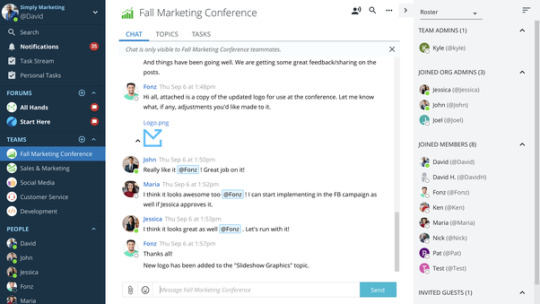
With emails, group chat, task management, and audio & video calls, Ryver allows the users to handle team communication in ONE APP. Ryver provides a discount to non-profit organizations and educational institutions, making it a useful team communication tool for them.
Features
Well Integrated
Task Management
Advanced Team Management
Custom Invite Links
Unlimited file sharing
Conclusion
We think the information on our blog will assist you in selecting the most appropriate technologies for communication software. Prior to selecting a chat tool, assess the demands of your business and carry out market research on the features, functionality, user or customer reviews, and other elements of the tool. As a result, you are not required to replace the tool even if it does not satisfy your needs.
#communication softwares#team communication tool#internal communication software#troop messenger#office chat software
1 note
·
View note
Text
What Are the Most Popular File Tracking Software Solutions in 2025?

In today’s digital age, managing and tracking files efficiently has become a critical part of maintaining workflow, productivity, and security. As more businesses shift to remote and hybrid work environments, the demand for effective file tracking system software has grown significantly. These tools help organizations manage, monitor, and protect their data, ensuring that files are accessed, edited, and shared securely. This article will explore the most popular file tracking software solutions in 2025, highlighting their key features and benefits. Additionally, we will discuss how Time Keeping Software and Time Tracking Software for Projects integrate with file tracking systems to provide a complete productivity solution.
1. Understanding File Tracking System Software
What is File Tracking Software?
File tracking system software helps businesses keep track of files across various stages of their lifecycle. This software records information such as who accesses a file, when it was last modified, and whether it was shared or downloaded. By monitoring these activities, file tracking software offers enhanced security, accountability, and data integrity.
Why is File Tracking Important?
Security: Protects sensitive information from unauthorized access.
Compliance: Ensures files meet industry regulations and standards.
Efficiency: Helps organizations maintain smooth workflows and avoid file loss.
Accountability: Tracks who is responsible for files at any given time.
Read more 👉 Time Tracking Software with Screenshots: A Compressive Guide 2024
2. Most Popular File Tracking Software Solutions in 2025
1. DocuSign
DocuSign is a leading electronic signature software that also offers powerful file tracking capabilities. It allows businesses to manage and monitor the lifecycle of their documents, from initial creation to final approval and archival.
Key Features:
Real-Time File Tracking: Tracks the status of documents in real-time, showing who viewed, signed, or modified the document.
Audit Trail: Provides a complete audit trail for all document activities.
Integration with Other Tools: Syncs seamlessly with various CRM and file management systems.
Benefits:
Improves document security and workflow efficiency.
Provides legal and compliance documentation for businesses.
2. M-Files
M-Files is a document management and file tracking software that uses metadata to automatically organize and track files. It helps teams keep track of documents by categorizing them according to specific attributes, rather than relying solely on traditional folder structures.
Key Features:
Metadata-Driven File Management: Automatically categorizes files using metadata to improve searchability.
Version Control: Tracks changes to files, ensuring users always access the most recent version.
Integration: Connects with popular enterprise software like Microsoft Office 365 and Salesforce.
Benefits:
Reduces time spent searching for files.
Ensures data security with access control features.
3. SharePoint
Microsoft’s SharePoint is a robust collaboration and file tracking platform used by organizations of all sizes. It allows businesses to store, share, and track files with real-time synchronization and version control.
Key Features:
File Sharing and Collaboration: Enables secure sharing and real-time collaboration on documents.
Version History: Keeps a full history of edits made to a document, with options to revert to earlier versions.
Secure Access Control: Allows businesses to control who can view or edit documents.
Benefits:
Enhances team collaboration and productivity.
Offers a secure and scalable solution for file management.
4. FileCloud
FileCloud is an enterprise-grade file management solution that offers file tracking, secure sharing, and collaboration tools. It is known for its strong security features and is often used by businesses with sensitive data.
Key Features:
File Versioning: Keeps track of every change made to a document.
Advanced Search: Provides powerful search capabilities to quickly find files.
Custom Branding: Offers customizable branding for a personalized user experience.
Benefits:
Excellent for businesses that require strong security and privacy.
Seamlessly integrates with other business tools and systems.
3. Integration with Time Keeping and Time Tracking Software
Streamlining Time Tracking with File Management
In addition to file tracking, many businesses also require time management tools to monitor employee productivity. Integrating Time Keeping Software with file tracking systems can offer several benefits. For example, businesses can track the time spent on specific files or documents, which can be crucial for project management, client billing, and productivity analysis.
Time Tracking Software for Projects
Project-based teams can benefit significantly from integrating Time Tracking Software for Projects with file tracking systems. This combination allows managers to:
Track Time Spent on Files: See how much time is being dedicated to specific documents or tasks.
Monitor Project Progress: Ensure that project deadlines are being met and tasks are being completed on time.
Accurate Billing: For client-based projects, businesses can accurately track hours spent on tasks and provide detailed invoices.
Benefits of Integration:
Efficiency: Reduces manual tracking efforts and increases automation.
Transparency: Provides clear insights into how time and resources are being used.
Accountability: Ensures that both files and time spent on tasks are properly documented.
Read more 👉 Best Strategic Planning Software in 2024
4. How to Choose the Right File Tracking Software
Assess Your Business Needs
When selecting file tracking software, it’s crucial to assess the unique needs of your business. Consider factors such as:
The level of security required for your files.
The complexity of the documents you handle.
The size of your team and the software’s scalability.
Look for Key Features:
File Search and Retrieval: Ensure the software has a robust search function.
Audit and Version Control: Choose software that offers detailed audit trails and versioning capabilities.
Integration: Ensure compatibility with other business tools, such as Time Keeping Software and Time Tracking Software for Projects.
Consider Cost and Support
Cost: Compare pricing plans and find a solution that fits your budget.
Customer Support: Look for a provider that offers excellent customer support to assist with any issues.
Conclusion
As we approach 2025, the demand for effective file tracking system software is higher than ever. The most popular solutions, such as DocuSign, M-Files, SharePoint, and File Cloud, offer powerful features to ensure file security, enhance collaboration, and improve productivity. By integrating file tracking software with Time Keeping Software and Time Tracking Software for Projects, businesses can streamline their operations, improve time management, and ensure greater transparency. Choosing the right file tracking software depends on your specific business needs, so make sure to assess your requirements before making a decision.
0 notes
Text
Salesforce Files Connect SharePoint Integration for Seamless Collaboration
Unlock the full potential of your Salesforce environment with Salesforce Files Connect SharePoint integration. XFilesPro offers expert solutions to effortlessly connect Salesforce with SharePoint, enabling secure document management, efficient workflows, and improved team collaboration. Learn how to leverage this powerful integration to streamline your business processes and enhance productivity. Explore our resources today!

1 note
·
View note